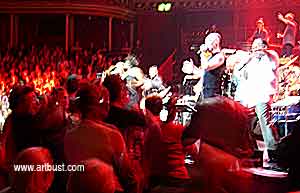|
|
James Last
|
||||||||||||||||
 |
|||||||||||||||||
|
Listen to POPMUNDIAL'S "JAMES LAST RADIO": |
|||||||||||||||||
|
ProloWgue: In February 2010 we (me, the producer, Yours Truely Joe), Popmundial, decided that is is time to dedicate part if not a whole radio station to the music of James Last. Music which is timeless but almost With compliments to Hansi I launched and paid Radio 2, a James Last Radio from 2010. This James Last Radio is thought to re-group or better have a home for all Last-fans - but ALSO win over new fans. I myself could tell stories of people who had prejudices but - after a concert visit - had tears in their eyes! Let us do something special with this JAMES LAST RADIO online as special interest service of Popmundial Radio (www.popmundial.co.uk) ! Background: I was tired over all these last 20 years as a music journalist, that there is no media interest (besides celebrating Hansi's 80th) or if - that his real achievement wasn't recognised. I was running the jameslast.com some 30 years ago but handed it over to the label Popydor, yet. That moment started my own biography
- from my point of journalistic view.
Consider the great sounds that have gone
around the world - the most recognisable that are: Glenn Miller,
Ray Conniff, Herb Alpert, Mantovani, Count Basie,, Percy Faith,
The Carpenters, Bert Kaempfert He is an international artist - born in
Germany and still touring despite the huge costs of staging live
concerts. A James Last concert means a massive number of players:
the team, crew, the James Last Band, the orchestra, full string
section and singers. James Last still fills the Royal Albert
Hall in London, not for a single concert only, but for a week
(and this has been happening since 1971)! What a phenomena. James
Last attracks audiences of all ages!
That was the time "we", Artbust and his partners, including West One News, the successor of Euroshowtime and impresario Dietmar Bohne, met Hansi, as James Last is known, for the first time when his records were flying off the shelves in Germany in the late 60s and early 70s. We share lovely memories. This article is not a fan club approach to Hansi. But seeks to explain the phenomenon that is James Last. Over the decades we were there when it happened, reporting for public and private radio stations. Here is the only comprehensive English version of his biography:
Hansi's ambitions were to conduct opera and lead a symphony orchestra when he began his music studies at the Heeresmusikschule in Bückeburg in 1943. His favourite instrument became the bass. He went on to study at the Bremen Music Academy and the Army Music School in Frankfurt, which after the war brought him in touch with American popular music of that time - Jazz. He became proficient on several instruments; his main instrument was the double-bass which he played in various jazz groups.
During this year, Hansi set up an offshoot dance orchestra with his brother Robert on the drums. This band became famous as the "Last Brothers Orchestra". At this time the third brother, Werner, went to America to study music. He later became famous with his own band under the name "Kai Warner". Although Robert subsequently had its own band he continued to play drums with Hansi up to the mid 60s. In 1948 they became the "The Becker-Last Ensemble", playing American-style big-band jazz music. "We want to proof for the world that Germany had much more to provide than march music…" Hansi later recalled. That band lasted seven years. In 1955 Hansi married his girl friend Waltraud. The marriage lasted almost 50 years until her death in 1997. That same year he was with the North German Dance Orchestra, the "NDR Tanzorchestra", where he built a reputation as an arranger. Together with later famous artists such as Kurt Edelhagen and Bert Kaempfert he worked for German "Polydor Records", a subsidiary of the classical music label "Deutsche Grammophone Records". There he accompanied and arranged for stars such as Caterina Valente, Freddy Quinn (including film music such as the German hit "Junge Komm Bald Wieder ") and bandleader Helmut Zacharias, for whom he also toured and wrote the arrangements. If you find a single of one of these artists you will see the first mention of the "Hans Last Orchestra" quoted beneath the soloists. From that period there are also some rare
recordings of Hansi playing the double-bass with Helmut Zacharias,
who played the violin in the Menhuine style, jazzy and hot. Look
out for a solo of Hansi playing the double-bass on the following
track called " C JAM BLUES" by Duke Ellington, filed
under the artists names "Helmut Hansi finally formed his first orchestra
under his own name in 1964 and was signed to record for Deutsche
Grammophone Records. Until then he had performed as Hans Last,
but in 1965 he changed it to James Last. So Hansi came up with the idea of recording rock classics. They were actually still pretty newtracks at that time. Not to say these tracks he selected were "just" charts successes many were already anthems, but for another generation - the youth culture. It was the time The Beatles and The Rolling Stones had conquered what was before a modest and quiet music market, bringing about a revolution in youth culture. Their music stood for a mind-boggling change in society, a new way of life that was utterly rejected by the older generations as being a symbol of declining moral values and lacking responsibilities. The gap between young and old had hardly ever been more divided before. Preciously in this moment, a well-groomed young man in his mid thirties turned up to rearrange the hits of those longhaired "troublemakers", making their unfamiliar tunes somewhat more tangible, even danceable. On July 15th 1965 "Non Stop Dancing"
entered the top 40 of the sales charts and stayed for as many
as 60 weeks, along with albums such as "Beatles For Sale"
and "Rolling Stones No.2". Listen to our podcast "The James Last
Story", part 1, covering this period:
This approach had a very simple origin. Hansi was fed up with the stiff polite ceremonies of parties he was invited to. The always seemed to peaked with a Mantovani record or, at best, with a Trini Lopez record in order to boost the mood of the party. "If a party mood is not going to be generated by the people", Hansi thought, "at least it should come from the record player". So born was the concept of a 20 minute party blend, that is to say one side of a vinyl record.
It was at this time that stereo sound was gaining in popularity. Hansi found a remarkable simple but electrifying perfection for his sound: he split also the trumpet section positioning two players on each side of the orchestra - two trumpets from the left speaker and two from the right. This sounds simple but it was effective and innovative at that time.
In the first 5 years of his career he released about 40 albums, roughly two thirds of which reached Gold status. One album stands out in particular from that set of productions: James Last's version of the musical "Hair" (1969). For the pretty bourgeois, a ticket to see revolutionary stage production of "Hair" equalled a ride to Sodom and Gomorrha, since it overtly treated subjects likes conscientious objection to military service and free sexuality. Hansi, a well-established star of the bourgeoisie, had one comment: "Hair is great - let's do it!" Instead of arranging it in the "Non
Stop Dancing" - manner, he looked for new sounds, experimenting
with tape recorders running backwards, putting glass bottles
of microphones (remember, we still haven't entered the computerised
age!) or alienating the brass, varying rhythms and tempi. With
his arrangements virtually he created the musical anew - "Hair"
can be considered to be one of the best productions of first
years.
The German Second public television channel
became involved with the band, broadcasting them live on Hansi is also a renowned composer. Some
of his compositions are standards, such as "Fool" for
Elvis Presley, "Happy Heart" for Andy Williams, "Games
That Lovers Play" for Eddie Fisher, "Blame It On Me"
for Ray Charles, "Music From across the Way" or "The
Lonely Shepherd" for Gheorghe Zamfir,
Another reason for his tremendous success story is the fact that Hansi has a great knack of picking up new sounds and artists. "The Beatles at my time where condemned by my fellow artists", he remembers, "I realised very early: You must relay on the new sounds of a society. New developments are important. Living this way I managed to stay young forever!"
This explains why he is enthusiastic about songs of Michael Jackson as well as those by Guns n´Roses, Nirvana, Cher. Or way he recently featured "When September Ends" by Green Day at his September 2007 Albert Hall series of concerts. The "Gentleman Of Music" does not baulk at hip hop either. For the 1999 single release "Ruf mich an" he teamed up with German (gangster) hip hoppers "Fettes Brot" (Fat Bread) and the results proved his ability to connect the young and the old. Hansi is also very proud of the "Kill Bill" treatment of the "Lonely Shepherd", mentioned earlier, by the American "RZA" in 2004. Whatever melody receives the James Last treatment becomes a classic in its own right. Some call it the "Last Sound". Certainly there is in theory something in common between the entire recordings from polka to pop to the Classics. But it is the honest approach of Hansi, who "always tried to bring his personal input and the feelings of the moment in the track", as he describes it, that made these tracks great Last tracks . Hansi, as he is still called by his fans, varied the "party formula" and transferred it to other musical genres. He took songs from almost all musical genres (classical music, country, polka, Abba, Beatles, Swing or Latin), from various countries (Ireland, Russia, Switzerland, Scotland, even Japan) and he was always keen to host and accompany guest artists. These collaborations have also produced some outstanding albums. We want, in particular to highlight two which I believe are landmarks in James Last's work.
This album also is a landmark recording because it featured Hansi's son, Ron, to collaborate on the album as composer, singer and arranger. Ron Last is today the backbone of Hansi.
He took over most of the organisation. He coordinates the recordings
and looks after the whole of the productions side of things.
When computers have entered the studios and drastically changed
the work of sound engineers, Ronnie gradually took over the work
of a close backstage hand, who was with Hansi from the very beginning:
Peter Klempt, the Polydor sound engineer, who guaranteed the
James Last Sound on record and in live concerts. Since the mid
1990s Ron has been on the mixing desk for all productions. He
also supervises the live sound in concerts. When Ron speaks of
his work, it turns into a seminar for apprentices. In Hansi autobiography
(Metro Publishing UK or Heyne Munich) Ron reflects: "Peter
Klempt mixed more spatial, in particular for the rhythm. I mix
the whole band like a stereo image: at the "front"
is the rhythm, which is relatively dry, and at the back there
are the string section with the appropriate reverberation." James Last always warmly welcomed the advent of modern technology. At the age of 60 he worked consistently on the opportunities that technology had to offer and for composing and arranging he swapped piano and manuscript paper for the computer. His son Ron Last supports his ideas. He often sits down on the computer or at the keyboard with his father and tours with Hansi.
Hansi always looks for collaborations with young soloists. The 1975 album "Well Kept Secret" was well to much kept secret,reads I should have gained more recognition. The album was released by Polydor in the USA (2371 558). The tracks point back to the jazzy days of James Last blending them with soul. "Love For Sale", "Jubilation" "Questions" bringing together artists like the Brecker brothers or Ernie Watts.
Relying on albums and tours for his success, as a result James Last collects trophies as other people are collect stamps! By the end of the 1980s Last had released over 50 albums and had sold 80 million copies worldwide! This results in more than 200 golden discs! He does not spend time thinking about retirement even at the age of "70-something". His diary is full of appearance dates. He is not scared as long as he finds enough time for his wife Christine and for a further great passion - golf.
The least is drumming the band into the new century, we think. He is young, flexible, a rock drummer, which in combination with the backbone on guitar, Erlend Krauser (since 1992), builds the base to reach out for new audiences. Guitars: Peter Hesslein (1971) and others
Bass guitar: Benny Bendorf (1969 - 2002) - Thomas Zurmuehlen (2002) Percussion: Herbert Bornholdt (1972) - Pablo Escayola (2001) Accordion: Jo Mendt (P.S.: He had his own band, too) Synthesisers: Tommy Eggert - Ron Last Piano, Organ and Keyboards: Guenther Platzek (1965) - John Pearce (1991) - Joe Dorff (2002) Trumpets: Leif Uvemark (1970) - Derek Watkins (1976) - Chuck Findley (2001, known also from the Herb Alpert Sound) - Lennaart Axelsson (1972) - Bob Coassin (1981) and amongst many others, the young and sportive (new) saxophone player Matthias Clasen (1999) and the James Last Singers with Simon Bell.
Facing everyone without prejudice, James Last's charisma is that of a happy, optimistic person who, as he states, "did not meet a single "bad guy" in his whole life". So is his music. So are his arrangements. "I only following my feelings. I am what I am - and I want to know people only as themselves - not what they pretend to be. I want to entertain and bring some relaxation to my audience". DIETMAR (JOE) BOHNE, revised 2007 - 2024 This presentation is part of the Popmundial Association's attempt online to support and promote such artists. "We go On!" (quote, Hansi) A personal note: Please don't believe everything you read on the "official sites" about James Last! It has to be said, that in media terms and by law, Hansi signed a contract with his record label long before the digital revolution is one of the artists who are doomed to be bound to the terms till the death! Sadly! Hansi we go on for you ! THIS MUSIC AND SOUND MUST LIVE ON!
Photos
Links:
Bonus Material:
|
|||||||||||||||||
|
© 1996-2010
London, renewed 2010 - 2024 France Artbust is a former enterprise of Popmundial Popmundial Facebook Community  |
|||||||||||||||||
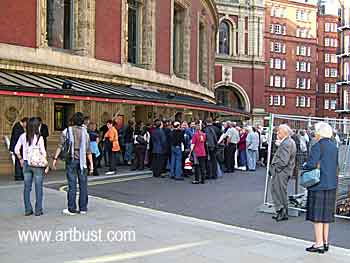
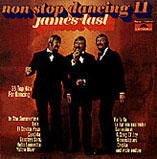 The first album "Non
Stop Dancing" in 1965 was a huge success. It was a blend
of well-known tunes with a jaunty dance beat in a richly orchestrated
manner with a lot of brass. He picked a selection of pop tunes,
arranged them in his unique "party style" and recorded
it live in front of an invited studio audience. One further attraction
of his party technique is incorporating claps, cheers and laughter
between each segueing track. In 1967 he had four LPs simultaneously
at the top of the English charts. 20 volumes of "Non Stop
Dancing" over a period of almost 20 years helped to make
Last "to last" and be a star across Europe.
The first album "Non
Stop Dancing" in 1965 was a huge success. It was a blend
of well-known tunes with a jaunty dance beat in a richly orchestrated
manner with a lot of brass. He picked a selection of pop tunes,
arranged them in his unique "party style" and recorded
it live in front of an invited studio audience. One further attraction
of his party technique is incorporating claps, cheers and laughter
between each segueing track. In 1967 he had four LPs simultaneously
at the top of the English charts. 20 volumes of "Non Stop
Dancing" over a period of almost 20 years helped to make
Last "to last" and be a star across Europe. 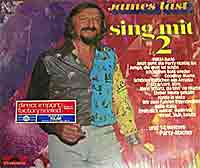
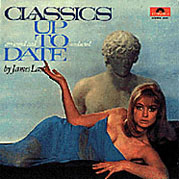 His
sound was become known as "happy music". Hansi found
other series such as "Hammond A Gogo", then "Sax
a Gogo", "Trumpet a Gogo" - "Classics Up
To Date" and so on. It was his record company that introduced
Hansi to the idea of making a Hammond organ album, which was
a popular instrument in the late 60s. Hansi put two of them on
stage - one left, the other on the right.
His
sound was become known as "happy music". Hansi found
other series such as "Hammond A Gogo", then "Sax
a Gogo", "Trumpet a Gogo" - "Classics Up
To Date" and so on. It was his record company that introduced
Hansi to the idea of making a Hammond organ album, which was
a popular instrument in the late 60s. Hansi put two of them on
stage - one left, the other on the right.
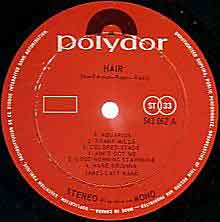
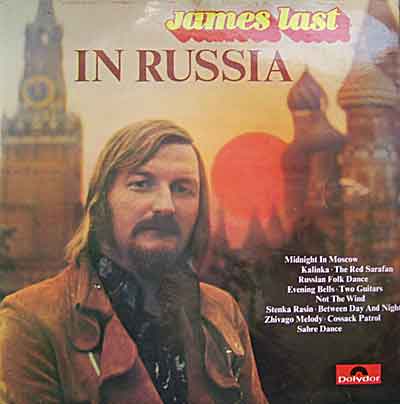
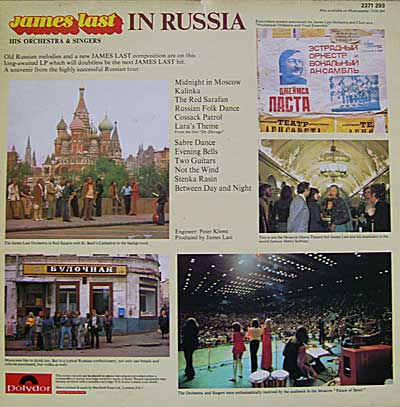
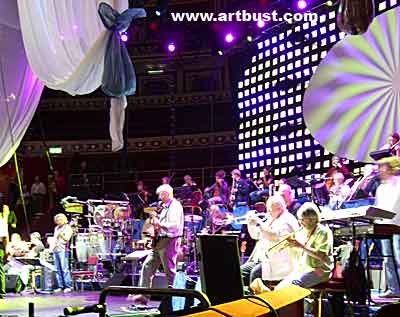
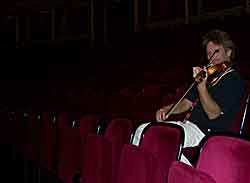 Hansi
respects his family and his musicians, all belong to the "James-Last-Family".
In the course of four decades many musicians have played in the
Janes Last band - so many that it would be impossible to list
all of their names. The number in brackets indicates the year
they joined the band:
Hansi
respects his family and his musicians, all belong to the "James-Last-Family".
In the course of four decades many musicians have played in the
Janes Last band - so many that it would be impossible to list
all of their names. The number in brackets indicates the year
they joined the band: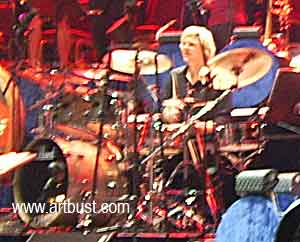 Drums:
Robert Last (1965) - Barry Reeves (1972) - Terry Jenkins (1978)
- now: Stefan Eggert (since 2002).
Drums:
Robert Last (1965) - Barry Reeves (1972) - Terry Jenkins (1978)
- now: Stefan Eggert (since 2002).